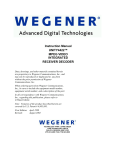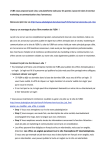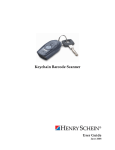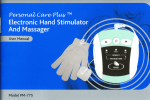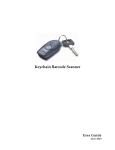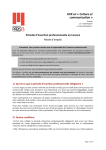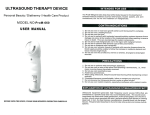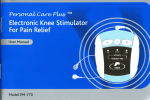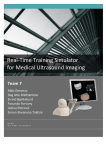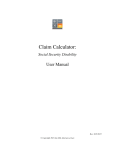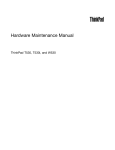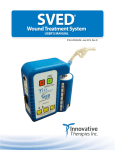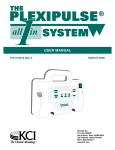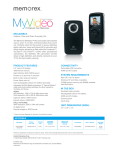Download nurse mar06-v5.qxd - Institute For Safe Medication Practices
Transcript
ISMP Medication Safety Alert!® NurseAdvise-ERR ™ Educating the healthcare community about safe medication practices Patient's watchful eye leads to pump tampering A hospitalized patient with chronic pain was able to increase the rate of DILAUDID) his HYDROmorphone (D infusion and administer bolus doses to himself. The patient had been receiving HYDROmorphone via a CADD-Prizm VIP pump (from Smiths Medical) at home before he was admitted to the hospital late one evening. The admitting physician prescribed the same dose of HYDROmorphone as the patient had been receiving at home, and allowed the patient to use his pump from home while in the hospital. given himself frequent boluses (not prescribed). The patient's home CADD pump was replaced with a hospital CADD pump (different model) and secured with a lock to prevent further tampering. Obviously, the patient knew how to manipulate the pump. He had obtained and used the lock level code to alter the pump settings, and the clinician code to give himself bolus doses. But how did he gain this knowledge? At the request of FDA and The others to provide readily The hospital-based pain patient accessible information, service team had been learned the the pump's user manual following the care of the codes by observpatient at home. But the ing practitioners is available on the manufacturer's website. This team was not notified of while programprovides patients with his admission until the ming the knowledge about how to following morning when a pump. program the pump. Howresident called them to quesever, the codes are not in the tion why the patient's web publications; they appear only HYDROmorphone was infusing at a in the hardcopy of the user manual different rate than prescribed. The that the facility receives. Thus, the team member told the resident that patient likely obtained the lock level they had not changed the dose and and clinician codes for the pump he would be unable to see the patient used at home by observing practitionuntil later in the day because of a ers programming the pump in the busy clinic schedule. The resident hospital. A much less remote possidid not investigate the change in the bility is that the codes, which are the infusion rate any further. same for this pump throughout the US when shipped from the manufacEighteen hours elapsed before the turer, had been communicated via pain service physician was able to visit the patient. Nursing documenta- the Internet or email by others. tion regarding how much medication While there may be no foolproof way should have infused differed signifito prevent patient tampering with cantly from the pump's electronic pumps, see check out! for several patient history log. When comparing the two, the physician quickly discov- things that healthcare providers can ered that the patient had somehow do to reduce the risk of tampering or manipulated the infusion rate and to detect it quickly if it occurs. it Newsletter Funding 2006 We are pleased to announce that McKesson will continue to provide ISMP with an educational grant to sponsor free distribution of Nurse Advise-ERR™ for the remaining 6 months of 2006. Join us in thanking them by emailing: [email protected]. Supported by an educational grant from McKesson March 2006 Volume 4 Issue 3 it check out! To reduce the risk of patient tampering with pumps that deliver opioids, or to detect such tampering quickly: Use hospital pumps. To enhance security, use only hospital-approved pumps to administer opioids to hospitalized patients. Do not allow patients to use their pumps from home. Shielding and scrolling. When programming a pump, always block the patient's (and visitor's) view and use the scroll up or down keys if available to prevent patients from counting how many times the keys are pressed. Checks and balances. Require the use of carefully designed flow sheets during opioid infusions to track cumulative doses over time (4-hour increments for inpatients) while referencing the pump's patient history log for comparison to the prescribed dose. Investigate. Consider the possibility of patient tampering (or an error) if the amount (dose and volume) administered does not match the prescribed dose, or if the patient's sedation level, respiratory status, or behavior appears different than expected. Patient education. Be sure patients understand how to report increasing or unrelieved pain. Some patients who experience difficulties with pain management are driven to extremes for relief. Provide assurance that you will contact their physician about unrelieved pain, who will subsequently assess and manage the patient’s pain more effectively. Staff education. When educating staff and other caregivers to use pumps, stress ways to minimize the risk of patients and visitors learning the programming codes. continued on page 2 ™ NurseAdvise-ERR Page 2 March 2006 Another risk of IV misconnections and free-flow The V.A.C. INSTILL SYSTEM by KCI is a wound healing system that facilitates automated delivery of topical solutions (e.g., Dakin's solution, silver nitrate solution, SULFAMY LON [mafenide acetate]) to wound sites. While very different from an infusion pump, the device is programmed to deliver irrigation fluid at a desired rate; but it lacks protection from gravity free-flow if the tubing is removed. Unfortunately, the V.A.C. is designed to accommodate IV tubing to deliver the topical solution. Thus, a nurse could inadvertently attach the "IV" tubing intended for the V.A.C. to an IV port. Previously reported misconnections of seemingly dissimilar tubing (e.g., blood pressure, oxygen, and air supply tubing) to IV ports should serve as a reminder that such an event is possible. In fact, there are a few additional conditions that heighten the risk of connecting the V.A.C. tubing to an IV line. Most V.A.C. topical solutions are prepared in "IV" bags, so both the bags and tubing look like those used to deliver IV solutions. The V.A.C. provides a detachable "IV" pole (as described in product literature) upon which to hang the solution. Finally, the V.A.C. is indicated for recalcitrant wounds, so it's used infrequently. Thus, staff may be unfamiliar with the device and unaware of the risk of misconnections. Furthermore, there will be no protection from gravity free-flow if the tubing is erroneously attached to an IV site and later removed from the V.A.C. Photos of the V.A.C. Instill System are available online at: www.kci1.com/866.asp. The reporting nurse has asked the manufacturer, KCI, to develop specific tubing that connects only to their equipment. Meanwhile, misconnections are less likely if you label all lines; physically trace all lines from the source solution to the port of insertion; and require an independent double check before initial use of the device, or when replacing bags of solutions. Additionally, ask pharmacy to apply an easily visible “For irrigation use only” label and a brightly colored overwrap before dispensing. Also consider asking pharmacy to prepare topical solutions in a container dissimilar to typical IV solutions, such as a 500 mL bottle. it Volume 4 Issue 3 continued from page 1 check out! Check security features. Check all pumps used for opioid infusions (and new pumps considered for purchase) to ensure that the locking mechanism for the compartment that holds the medication is functional and reliable. If it is not, request a replacement pump immediately. (Patients and visitors have used pens, paper clips, or other objects to push the syringe plunger, syringes with long needles to aspirate the medication, or moderate pressure to open the locked compartment.) Change codes. Some pumps offer biomedical engineering staff the capability of changing the lock level and clinician codes. Consider requesting a temporary code change for patients at risk for tampering with the pumps as long as the new codes can be securely communicated to all practitioners who need the information. Notify the pain service. If your facility offers a pain service, notify the team immediately upon admission of a patient with chronic pain, especially if the patient has been receiving opioids in the home setting. Special Announcement ISMP Teleconferences. Please join us for a two-part teleconference series covering Just Culture. Part I, Just Culture-An Emerging Safety-Centered Accountability Model, will be held on March 30, 2006. Part II, Journey Toward a Just Culture-A Statewide Initiative, will be held on April 19, 2006. Both programs will be held from 1:30 to 3:00 p.m. (ET). In Part I, David Marx, JD, will describe the basic tenets of a Just Culture, a groundbreaking way to promote an open and fair healthcare environment, especially as it relates to error investigation. (This is a repeat of our October 2005 teleconference.) Speakers for Part II will chronicle the statewide effort among healthcare providers and state licensing boards to adopt a Just Culture throughout the healthcare industry in Minnesota. Shirley Brekken, from the Minnesota State Board of Nursing, Tania Daniels, from the Minnesota Hospital Association, and Alison Page, from Fairview Health Services will be the featured speakers, each bringing a unique point-of-view to the experience. For details and to register, visit: www.ismp.org/teleconferences/tc.asp. Mosby’s Nursing PDQ for Medication Safety prepared by ISMP. This pocketsized reference has quick facts and errorreduction strategies for high-alert medications, look-alike drugs, high-risk procedures, and error-prone abbreviations. The guide also offers information and tips on assessing risk, error reduction, error reporting, and more. For information and to order, please visit: http://onlinestore.ismp.org/. ISMP Medication Safety Alert! Nurse Advise-ERR (ISSN 1550-6304) ©2006 Institute for Safe Medication Practices (ISMP). Permission is granted to subscribers to reproduce material for internal newsletters or communications. Other reproduction is prohibited without written permission. Unless noted, published errors were received through the USP-ISMP Medication Errors Reporting Program. Editors: Judy Smetzer, RN, BSN; Nancy Tuohy, RN, MSN; Michael R. Cohen, RPh, MS, ScD; Russell Jenkins, MD. ISMP, 1800 Byberry Road, Suite 810, Huntingdon Valley, PA 19006. Tel. 215-947-7797; Fax 215-914-1492; EMAIL: [email protected]. Report medication errors to ISMP at 800-FAIL-SAF(E). ISMP seeks an RN Medication Safety Specialist for publications. Details at: www.ismp.org/jobline.


